

STAR–POST (Music)



Intersections in Disciplines
As lifelong learners, how can arts educators explore connections with other disciplines and leverage technology to design rich learning experience?
Explorations with Found Sounds
Networks and Partnerships Arts As A Catalyst For Change
A collaborative and participatory community in partnership with arts communities can facilitate powerful conversations that impact and influence the teaching of arts in the classroom.
Giving Voice to the Voiceless






In light of social and cultural globalisation, arts education anchors values, nurtures students’ voices and imbues in students, a sense of identity and rootedness.
Honour, Values, Talent



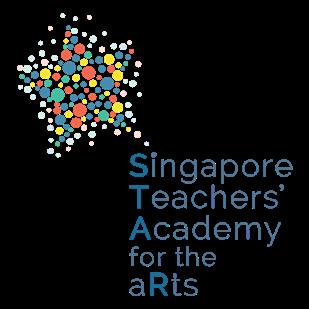
Editorial
elcome to 2019! As we start the new year, the STAR Post editorial team has put together the main highlights from last November’s Arts Education Conference (AEC) in a special issue, offering a myriad of provocative ideas and perspectives to kick-start your year in school.
With the outside-in perspectives gained from the sharing by overseas and local pedagogues as well as our teacher-presenters, the conference challenged us to rethink our roles as music teachers and widen our perspectives on how music should be taught and learnt. In this issue, we recall the powerful messages generated by the conference, including the following:
MUSIC HAS THE POWER TO CHANGE
Music has the power to change and transform our students in both attitude and values. It facilitates experiences that help ground our students in values and develop competencies that will help them navigate through the complexities and uncertainties of life.
The experiences we give our students will develop in them, not only skills and techniques, but more importantly readiness for life and work in a VUCA (Volatile, Uncertain, Complex, Ambiguous) world.
EVERYONE CAN SING AND MAKE MUSIC
Everyone can sing and make music. It is critical for us to embrace the musical voice of each of our students so that they will have the opportunities to express and experience music at a deep and personal level. As music teachers, we should have the courage to try the new and the unfamiliar as music teaches us to embrace the ambiguous and complex. In so doing, we build confidence in our educational connoisseurship and become role models for our students to thrive in an age of uncertainty.
We hope you will enjoy reading this issue. Let it seed your imagination even as we continue the post-AEC conversations on how we can expand our repertoire and make music lessons meaningful and inspiring for our students.
James Lee Deputy Director
(Music) Singapore Teachers’ Academy for the aRts
Intersections and Transformation
How does the theme of Intersections and Transformation open the space for us to examine creativity in the arts and the potential of the arts to facilitate engagement, innovation and optimism for the future?
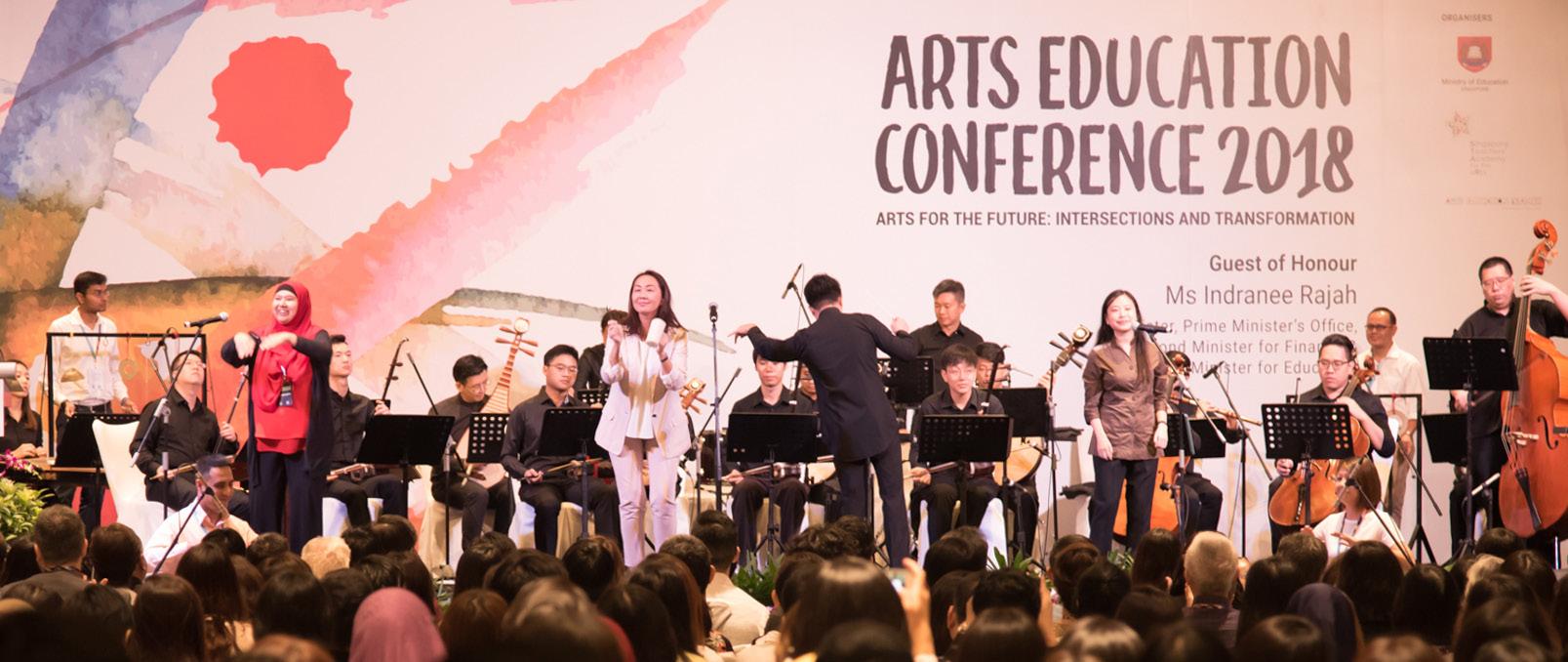
Music Master Teachers leading the arts education fraternity in collaborative music-making
READ About Arts Education Conference 2018 Intersections
Flushes of enthusiasm and excitement filled the air as the crowds eagerly queued for their conference tags, anticipating the programme ahead that would engage them in learning and open new perspectives.
The biennial Arts Education Conference (AEC) 2018, co-organised by the Singapore Teachers’ Academy for the aRts (STAR) and Arts Education Branch (AEB) saw a turnout of more than one thousand participants, comprising school leaders, teachers, and representatives from our arts partners. For the first time, the AEC saw the participation of our Dance and Drama colleagues. It was a gathering of arts educators who believe in the integral role of arts education in developing our students holistically and shaping the future of Singapore.
Themed “Arts for the Future: Intersections and Transformation”, the conference was graced by Second Minister for Education, Ms Indranee Rajah, and opened with a captivating and innovative performance by Ding Yi that showcased contemporary interpretations and crossed multiple disciplines.
The opening performance began with a unique percussion solo, played entirely on ceramic pieces. As a surprise feature, the solo line was continued on the video screen that had recorded STAR’s Senior Academy Officer (Music), Ms Adeline Tan playing on another set of ceramics.
More intersections await as the ensemble was joined by the three Music Master Teachers,
CLOCKWISE
Second Minister for Education, Ms Indranee Rajah’s entrance to the Arts Education Conference 2018
The teacher-musicians who performed the Opening with Ding Yi –
Ong Shi Ching Melissa Hai Sing Catholic School
Jonathan Tan Jun Qiang Telok Kurau Primary School
Gerald Teo Yin Song Stamford Primary School
Yick Jue Ru Dunman High School


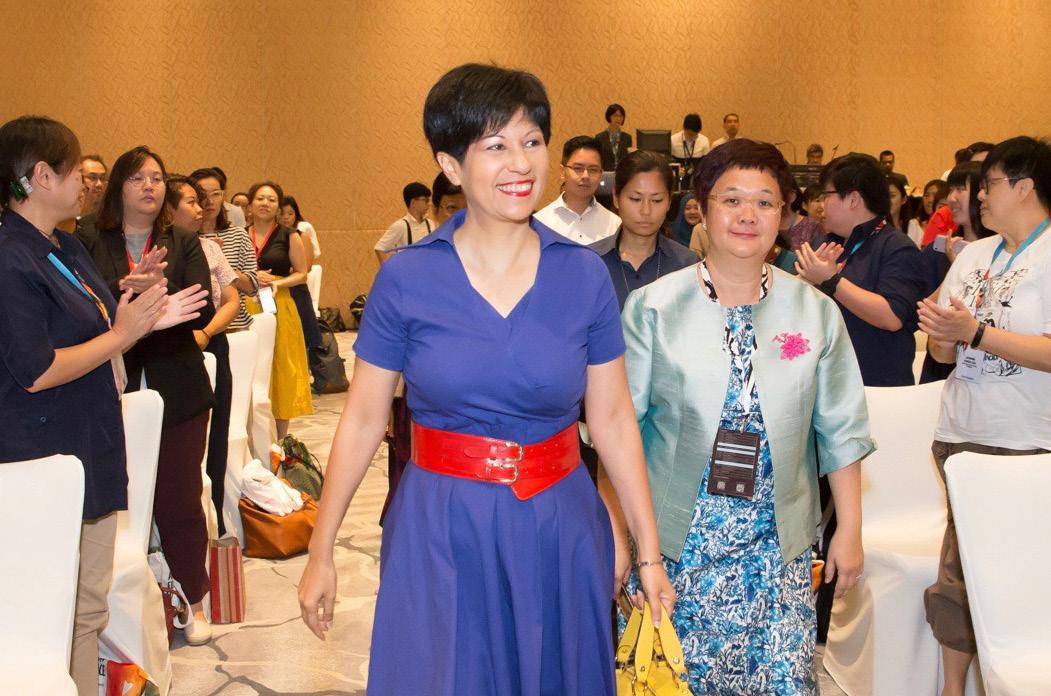


Mrs Li Yen See, Mrs Tan-Chua Siew Ling and Mdm Suriati Binte Suradi who led the audience in an interactive rhythmic segment as they played to the piece entitled “Intersections”. They were supported by volunteer teachers who helped lead the rhythm by playing on ceramics.
WATCH
This piece specially arranged by Music Master Teacher, Dr Kelly Tang, intricately weaved various thematic ideas found in three songs from the S tories We Sing 1 collection, namely, Masa Remaja (Time of Youth), 隐形的雪 yin
xing de xue (The Invisible Snow) and வாழ்ேவ
Vaazhway Olli Theebamay (Glowing Light). Each Master Teacher led in one rhythm which represented each of the three songs from Stories We Sing
More pertinently, ceramic pieces, randomly placed in selected tote bags, were used to play one of the rhythms. These ceramics were repurposed from castaways collected from various schools. Though regarded as unwanted, when placed in this performance context, they showed themselves capable of
Click to watch the multidisciplinary performance that crosses art, music and video 1Stories We Sing is a pedagogical resource commissioned to support music teaching in the classrooms. The songs draw from authentic life experiences in Singapore. It aims to engender cross-cultural understanding and foster a stronger sense of belonging and identity through meaningful music learning. For more information, visit https://www.star.moe.edu.sg/resources/ star-pedagogical-resources
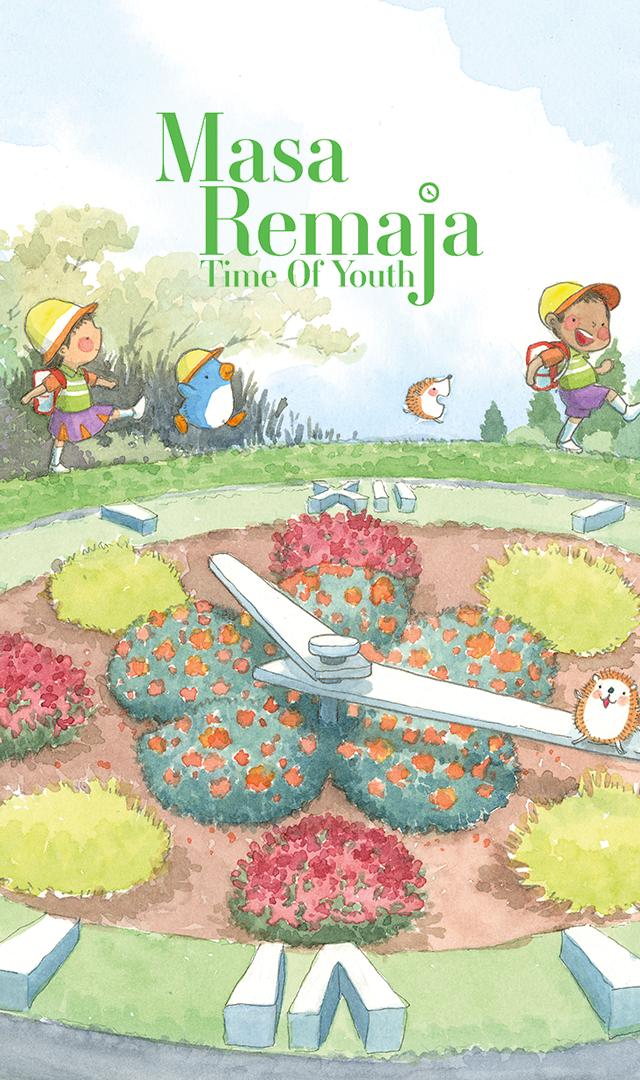
The three songs from Stories We Sing featured in the piece entitled “Intersections”

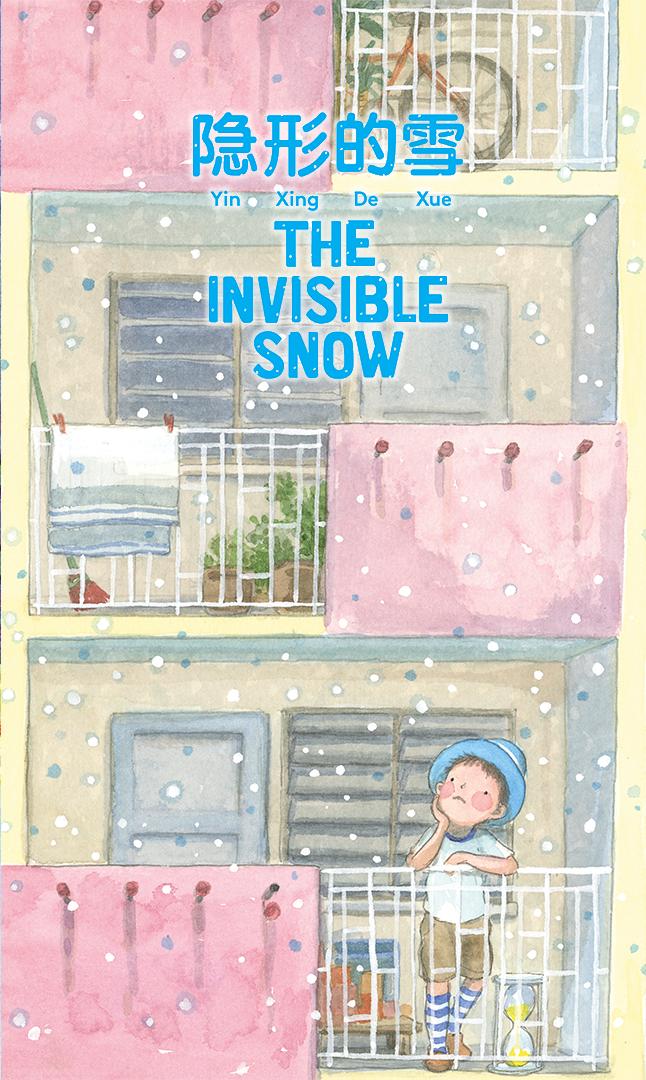
“Every person, just like every ceramic pot, has unique talents and abilities that can be harnessed and developed, and it is up to the teacher to use the arts as a tool to deepen their understanding of each child and nurture them.”
WATCH
Click to watch the performance entitled “Intersections” that weaves the themes of three songs from Stories We Sing
generating joyful sounds. This reminds us that every person, just like every ceramic pot, has unique talents and abilities that can be harnessed and developed. It is up to the teacher to use the arts as a tool to deepen their understanding of each child’s unique qualities and to nurture them.
Ding Yi was joined by four music teachers as instrumentalists, modelling how teachers can hone their artistic craft to impact their music teaching practices and inspire their students to pursue excellence in the arts.
Just like the music teachers featured in
“Music Teacher – Growing Musical Identities ”, they show how our musical experiences are broadened when we tune ourselves to be at our musical best, to forge creative musical possibilities and bring out the best in our students.
The opening was a delightful start to the conference, highlighting the conference theme, and inspiring the audience to imagine non-conventional intersections that can occur in music-making and explore how they can transform learning experiences.
Transforming Schools
How does an arts education build a nation’s next generation?
Second Minister for Education, Ms Indranee Rajah addressing the integral role of the arts in education

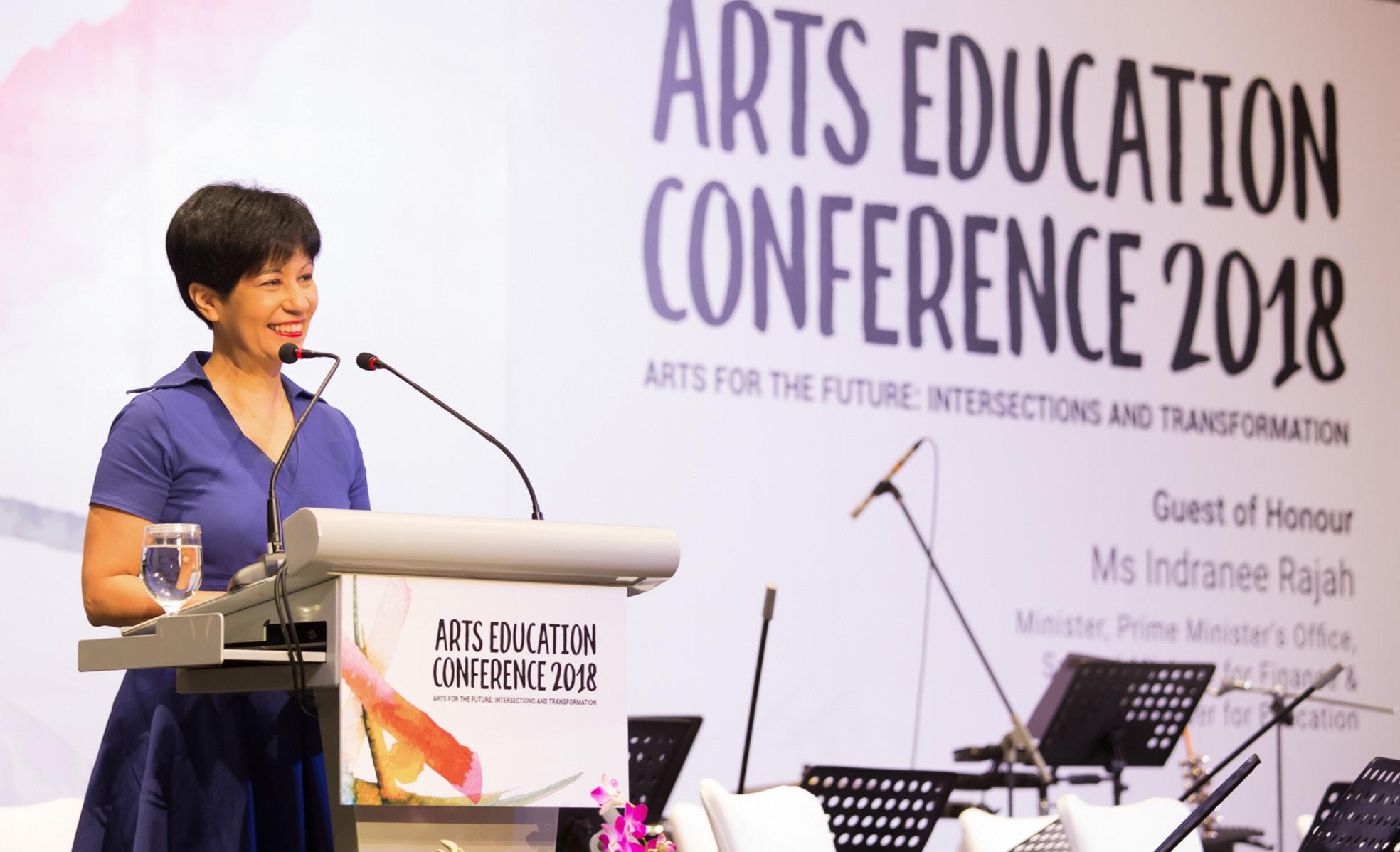

DEVELOPING FUTURE-READY TEACHERS AND STUDENTS
A process-oriented inquiry-based approach is one way to give time and space to our students to investigate and play as they engage in discussions. Discussing about artists’ inspirations, performers’ interpretation and audience receptions to the art works, helps our students better relate to their personal experiences, not only to express their feelings but to also listen to differing ideas and responses. Through this, they begin to open their minds to different perspectives which sets them to value diversity of ideas and respect for each other. These social and emotional learning skills remain ever critical in this 21 st century.
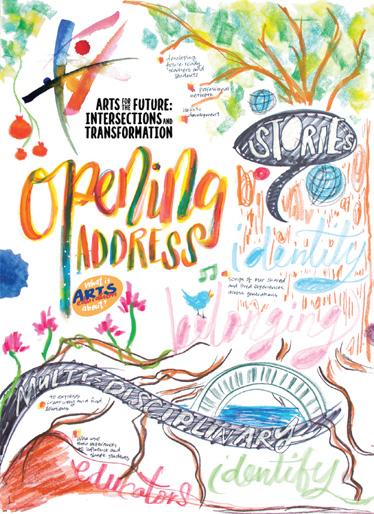
STORIES AND SONGS OF OUR SHARED

WATCH
Click to watch the Opening Remarks by Second Minister for Education, Ms Indranee Rajah

Arts Teachers as Catalyst for Change
Arts education has the power to effect changes in attitude and action. It is a pivotal platform to cultivate a sense of curiosity, discover interests, grow passion, and develop many life skills.
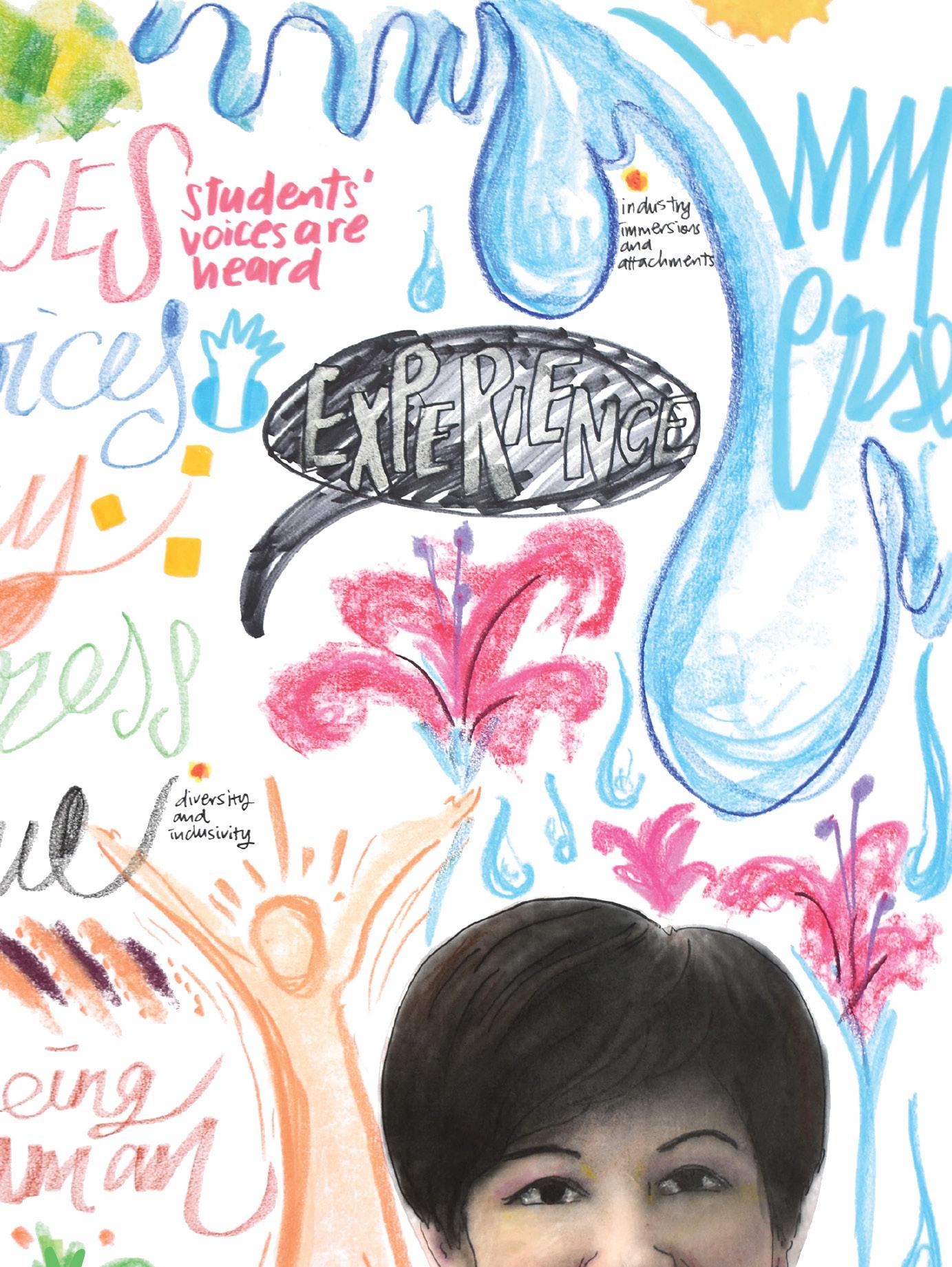
Q: How do we take the lead to champion the arts further and shape arts learning to influence our students, our communities, locally and even, globally?
Q: What creative ideas and insights did you gain that sparked interesting intersections?
AEC 2018

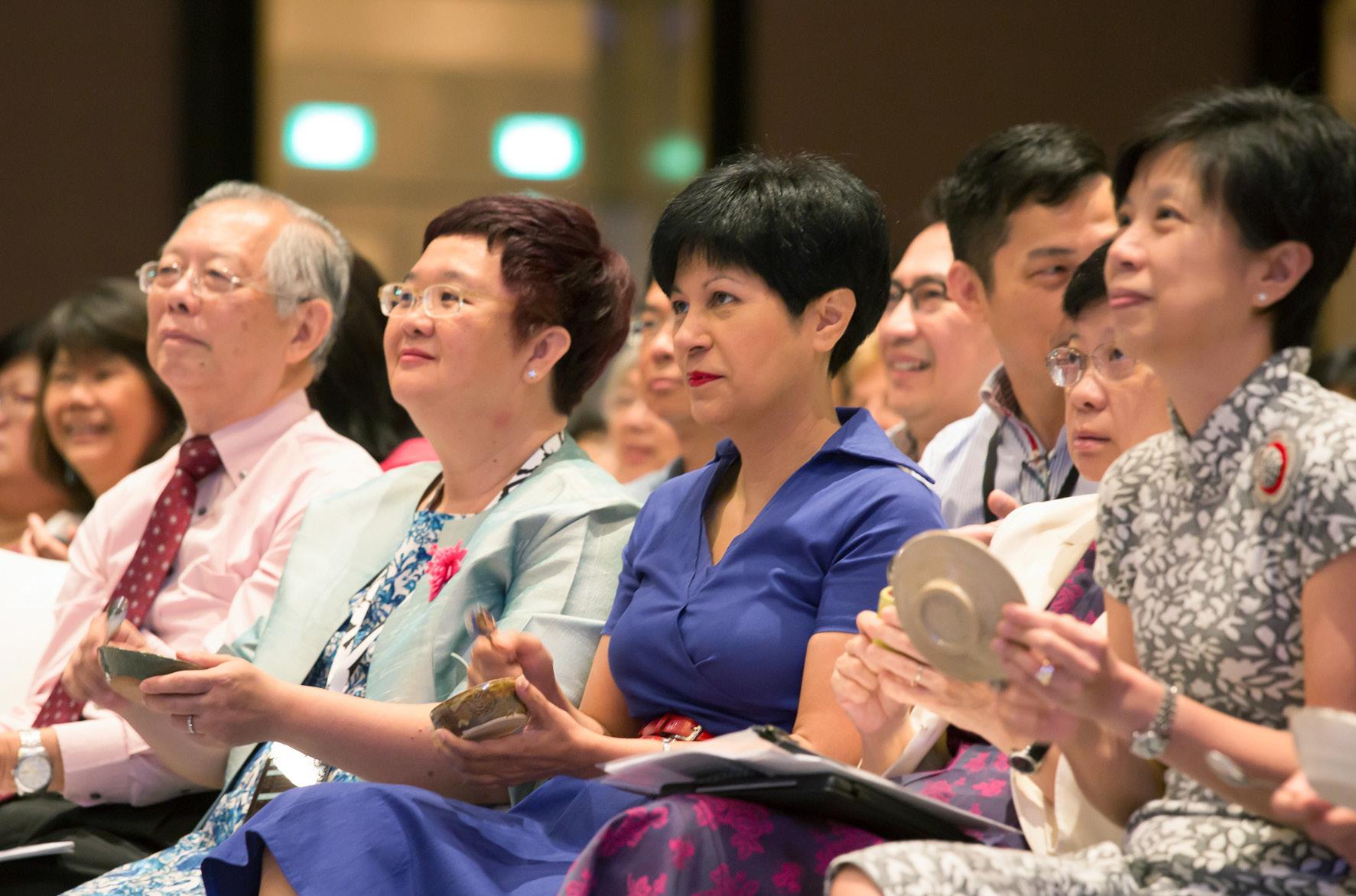


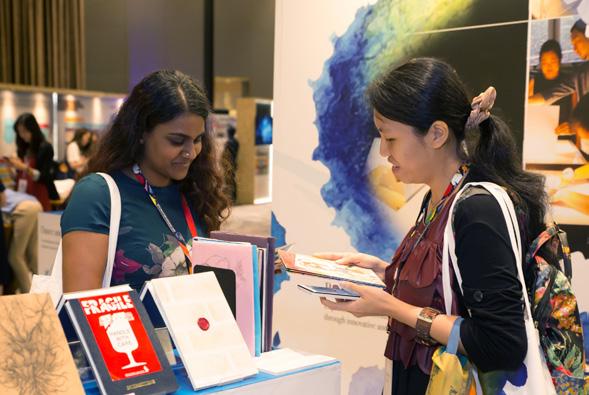









01 Our AEC tote bag containing valuable resources 02 Teachers exploring our arts exhibits 03 Making joyful sounds with ceramic pieces 04 Sharing ideas over coffee 05 Reflecting on our Arts teaching practices 06 Capturing good lesson ideas
07 Celebrating our learning 08 Array of lanyard colours representing the four Arts domains - Art, Music, Dance and Drama
09 Display Boards and Posters at the Canning room 10 AEC Conference Tags
11 Exploring the Student Learning Space (SLS) Booth 12 Our AEC emcees, Ira Wati Sukaimi from Mayflower Secondary School and Irene Loi Cheng Li from St. Andrew’s Secondary School
13 Students from Angsana Primary School, Fuhua Primary School and Tampines Primary School surprising our conference guests with an Engaging with Songs Flashmob 14 Catching up at AEC
15 An opportunity to interact with teachers from other schools

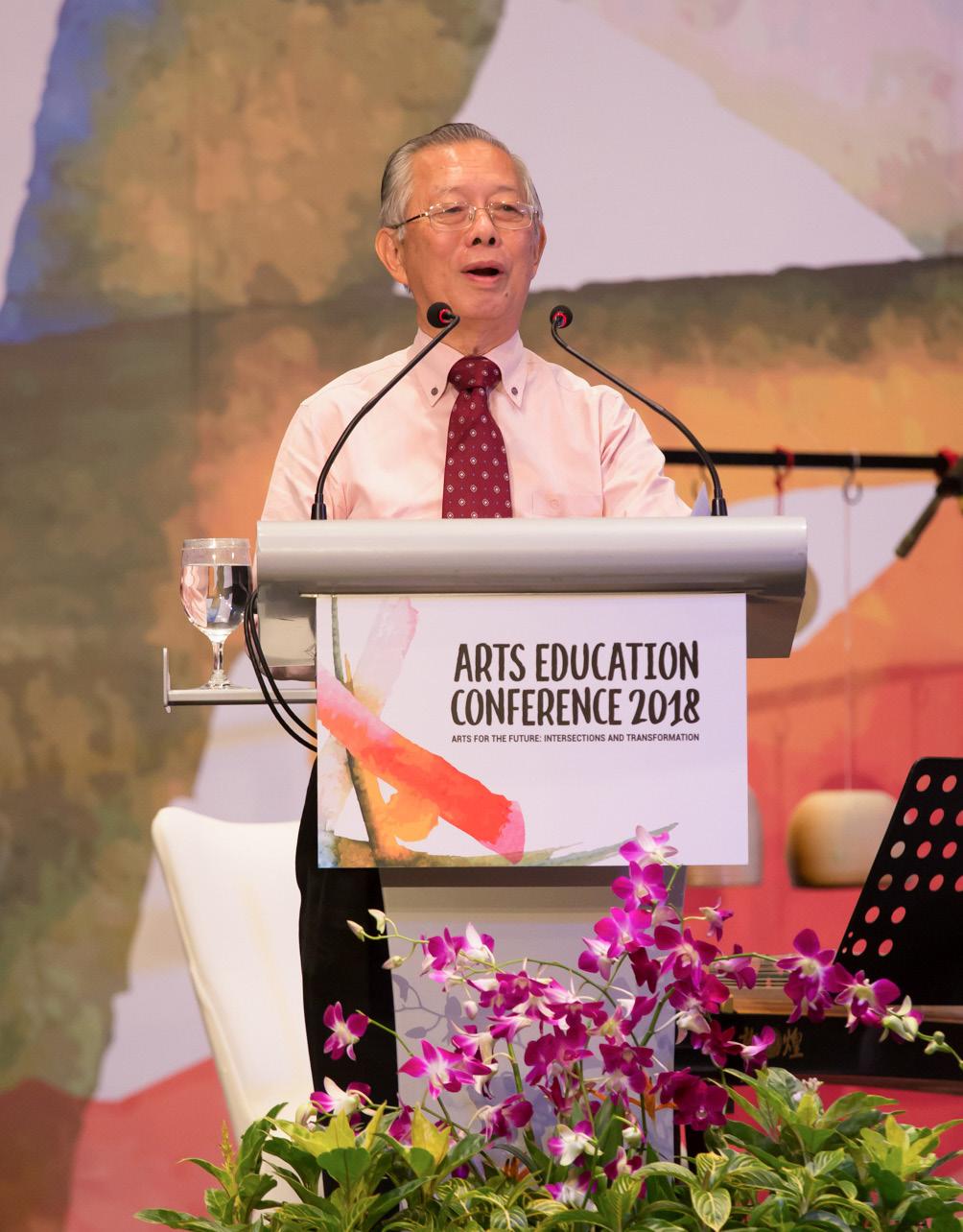
Honour, Values, Talent
The future is one in which the unseen becomes much more important than the seen. How can we learn to see, think and feel things differently in order to discover and create new
WATCH
Click to watch the Keynote by Mr Lim Siong Guan on Growing Beyond Talent

past 300 years. Thus, there is an urgent need for arts educators to imbue in our students a sense of curiosity and imagination to ask, what could the future be?
While we cannot predict what the future will look like, we know for sure that everything that could be automated, will be automated. However, the acceleration of automation has ethical implications and humanity will have to be anchored in honour.
Mr Lim Siong Guan speaking on the importance of honouring our humanity and talents
HONOUR OUR HUMANITY
What are the skills we need to teach so that

Talent not uncovered is missed
Talent not developed is wasted
Talent not expressed is unused
Talent not put to good use is squandered
HONOUR OUR TALENTS
Do you consider talent to be a matter of nature or nurture? For those of us who believe that talent is about nurture, we would think of different methods to motivate and develop our students’ talents. The story of “The Animal School” written by George Reavis illustrates that even the process of nurture requires differentiation in instruction depending on the natural skills and learning styles of the students. There is still a need to consider students’ innate talent. On the other hand, if we believe that talent is a matter of nature, we are responsible for spotting and developing that talent early and in the best way possible.

The idea here is not to decide if talent is a matter of nature or nurture. The most important thing is to recognise that each student is different and to honour these differences. Talent needs to be uncovered, developed, expressed and put to good use. We also need to honour the talents and abilities that we each have by applying them to good purpose and in so doing we discover our humanity in contributing to and enriching the lives of those around us and those whose path we cross each day.
As art and music teachers, we are in a good position to develop and bring out the best in every student. Success is never certain and the path is not predefined. We have to teach our students to reach out for the opportunity to do

good by observing, thinking, trying, learning, serving, leading and standing on what they believe. When we empower our students to lead a purpose-filled life, we make a positive difference in their families and society.
Dr Evangelos Himonides shares about the transformative power of creative musical participation, as manifested in a choir for throat cancer patients

Giving Voice to the Voiceless
Building a greater sense of identity, inclusiveness and belonging through the power of creative musical participation
Dr Evangelos Himonides, Reader in Technology, Education and Music, University College London, Institute of Education, believes that creative musical participation strengthens our individual identity, while helping people to bridge differences and to communicate. When circumstances such as health, disability or socio-economic factors threaten to erode a person’s self-confidence and their sense of belonging, music becomes an important and potent tool to help restore his/her quality of life.
severe depression and social isolation due to their inability to communicate with others.
READ
Click to view the slides on The Power of Creative Musical Participation by Dr Evangelos Himonides
With this in view, Dr Himonides shared about the ground-breaking work at Shout at Cancer , a UKbased charity organisation dedicated to helping throat cancer patients who have undergone laryngectomy rebuild their lives. As a treatment for advanced throat cancer, laryngectomy involves the removal of a patient’s entire laryngeal assembly, including the vocal cords. The laryngectomee (one who has undergone laryngectomy) loses any ability to speak using his/her vocal cords. While artificial aids such as the electro-larynx exist to help such patients “speak”, the procedure has a most debilitating effect, causing laryngectomees to suffer from
Dr Himonides and the Shout at Cancer team see it as their mission to use creative ways to give laryngectomees their “voice” back by innovating ways in which they can vocalise and express themselves musically. They founded a choir for throat cancer patients to sing together for the public, performing a special musical repertoire designed around their unique vocal capabilities, thus raising public awareness about their condition. The Shout at Cancer choir has helped members restore their sense of self-confidence and to have a fresh sense of belonging in society.
Another ingenious innovation by Shout at Cancer was to introduce beatboxing to the laryngectomees. Beatboxing offers a way for them to vocalise music without the need for a voice box.
Shout at Cancer even brought in professional beatboxer Marv Radio to help laryngectomees learn beatboxing techniques. In an interesting
“Teachers cannot be passive recipients and consequent conduits of predefined educational practice. They need to be in a position to shape their own and their students’ learning, and critically assess their needs as these are being formed.”
Dr Evangelos Himonides
turn, Marv Radio experimented with using an electro-larynx in his beatboxing, with most interesting musical results. This beautifully demonstrates how creative possibilities expand when our conversations become open to a greater multiplicity of voices and perspectives.
The approaches and outcomes of the Shout at Cancer choir has deeply profound implications for music education, as distilled by Dr Himonides:
• OUR VOICE IS OUR IDENTITY
The plight of laryngectomees shows that when we lose our voice, we are denied our primary means of connecting with the world, with others and with ourselves. Our voice represents our personal identity. It expresses who we are and defines our place in society.
• EVERYONE CAN SING
Click to watch the Spotlight Session on The Power of Creative Musical
Because having a voice is absolutely integral to being human, Dr Himonides passionately believes that every person can sing. Singing celebrates the beauty of the human voice, and it is intrinsically connected to the dignity and value of our personhood. Challenging the notion that some people are amusic (tone-deaf and incapable of processing pitch), research by Dr Himonides and his team has shown that, of over 13,000 primary school students tested in the UK, even the least musically competent ones could learn to sing.
• MUSIC IS PLURALISTIC
able to produce a specific type of vocal tone or having a wide vocal range. Such an exclusive view deprives those who do not fit these requirements, the opportunity for musical expression, development and participation through singing. Instead, music educators need to be open and sensitive to the differentiated vocal ability of each student, and select repertoire that enables each student to sing within his/her range. As the Shout at Cancer choir has triumphantly proven, singing can take on diverse styles and expressions to suit the singer, beatboxing included. If people without vocal cords can sing, who else cannot?
Singing is not simply a pastime for the elite, but an essential part of being human. This poses an immense challenge to all music educators. How should we curate and listen to our students’ voices as instruments that are deeply connected to their personhood? How do we help students value their own voice through music, and honour the voices of others through creative collaboration?
As Dr Himonides states, “Teachers cannot be passive recipients and consequent conduits of predefined educational practice. They need to be in a position to shape their own and their students’ learning, and critically assess their needs as these are being formed.”
Just as new strategies were innovated by Shout at Cancer to help laryngectomees sing, the challenge for music teachers is to craft innovative approaches to singing, customised to the musical profile of their students –lessons that inspire them to sing their hearts out. WATCH
Participation by Dr Evangelos Himonides
As Dr Himonides explains, a big problem arises when the ability to sing is defined by a privileged set of parameters, such as being
REDEFINING HOW MUSIC IS MADE
Sounds may be invisible yet they exist everywhere. The sounds of the world around us can be a source of inspiration to draw ideas from, to reimagine possibilities and to serve as material to mould into a musical narrative.
One Instrument, Many Voices
From the cello to the sounds of the world around us, Bossa Celli’s provocative performance challenges us to rethink the way we make music
Bossa Celli with James Ng Wen Liang from Pei Tong Primary (second from right) as one of its members, kick-starting the AEC 2018 afternoon programme with an invigorating performance
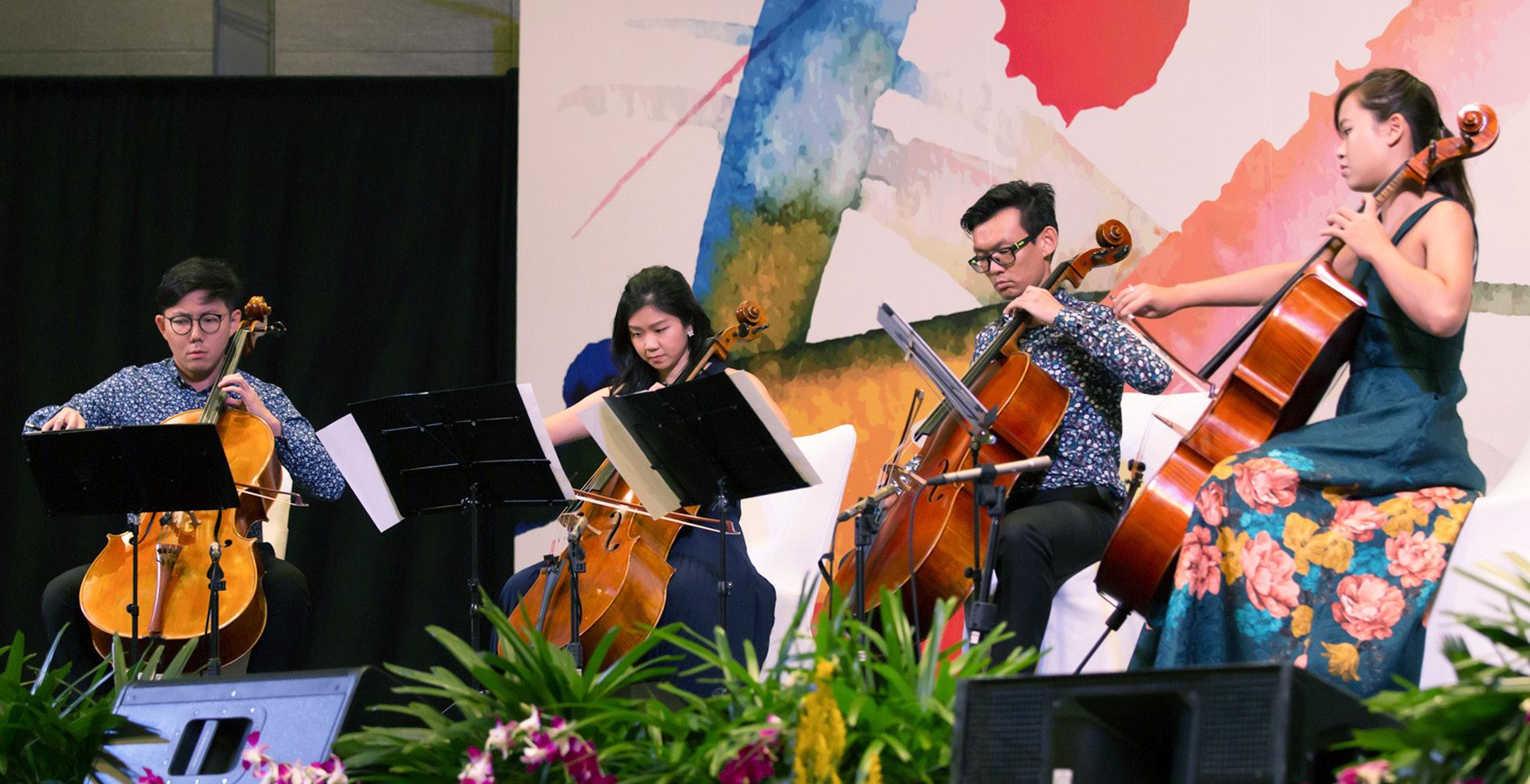
WATCH
Click to watch Bossa Celli
Perform an arrangement of My City, My Sayang
Going against the established grain, Singaporean ensemble Bossa Celli puts a fresh and exciting spin on the idea of a string quartet. Instead of the usual two violins, a viola and a cello where each instrument performs an assigned role within its designated registral space, Bossa Celli featured four players performing the same instrument – the cello.
The afternoon programme was an intriguing mix of three musical pieces beginning with My City, My Sayang (from Stories We Sing ), followed by an invigorating soundscape depicting the colourful sonic events surrounding the daily life of a school teacher,
all using just the cello, and ending off with La Muerte Del Angel by Astor Piazzolla.
But why use only the cello – a “bass” instrument – when it is the viola that customarily plays the nimble accompaniment figures in the middle range, or the violins that play melodic lines in the upper registers? Asking such questions misses the point of Bossa Celli, as this ensemble aspires to break out of conventional moulds, and explore new musical directions. Keeping to just the cello, Bossa Celli makes an important three-fold statement about the nature of music-making which reshapes our perspectives as musicians and music educators.
WATCH
Click to watch how the cello can create a myriad of sounds that reflect the sound of the world around us
1. ONE INSTRUMENT, MANY SOUNDS
We do not need different instruments to make a multiplicity of sounds. A single instrument can be played in various ways to produce a variety of timbres that keeps music interesting. Bossa Celli’s masterful performance featured different parts of the cello being bowed, plucked, snapped and struck, generating a kaleidoscopic myriad of sounds that kept the audience captivated.
Q: As music teachers, how do we encourage students to discover different sounds that instruments can make? And how can they apply these new sounds to make the music more engaging?
2. INSTRUMENTS ARE NOT RESTRICTED TO FIXED
ROLES
WATCH
Click to watch Bossa Celli’s performance of La Muerte Del Angel
It is sometimes taught that each instrument has a preordained role to play - guitars strums chords, drums keep the beat and voices sing the melody. In Bossa Celli’s performance, however, the cello did not simply play the bass line, but also typically “un-cello” roles, such as arpeggiated accompaniment figures, soaring lyrical melodies, languid counter-melodies, thundering octave-unison passages and percussive drum beats.
Q: How do we help students explore alternative roles that instruments can play, rather than restrict instruments to fixed conventional roles?
3. NO LINE DIVIDING MUSIC AND THE WORLD
In their astounding soundscape performance, Bossa Celli demonstrated how the versatility of the cello extended beyond playing different musical roles, to realistic imitations of various environmental sounds, ranging from the faint buzz of a mosquito and a beeping alarm clock, to the roar of heavy traffic and the mooing of cows. By blurring the line between “real-life” sounds with music, Bossa Celli demonstrated how sounds of the world around us provide inspiration for musical ideas, and how there is another form of music that goes on in the fascinating flow of sounds around us.
Q: How do we help students connect music to the world of sound around us, such that music becomes an expression of life?
By their adventurous spirit to transcend conventional boundaries, to perfect their musical craft and to relate music to real life, Bossa Celli’s performance is an inspiration to us as music educators, to continually open our mind, and that of our students, to the infinite world of music that is in and around us.
Music Producer Evan Low on using sounds around us to develop compositional ideas
Explorations with Found Sounds
As we listen closely and deeply to these sounds, what do we hear and how do we utilise these sounds to enhance our compositions?

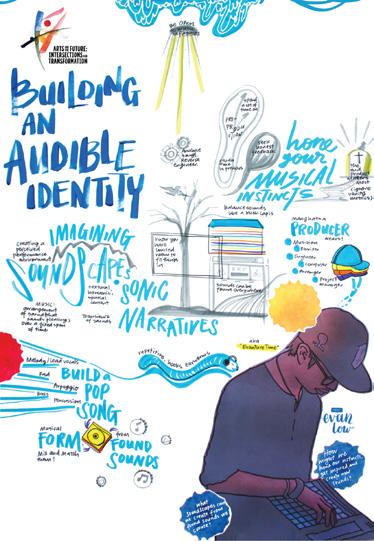
From Bossa Celli’s performance where we hear infinite possibilities of sounds emerge from a single instrument, our ears are transported to an inverse musical world where everyday found sounds are manipulated to create music, redefining the processes of music composition.
In his masterclass, music producer Evan Low shared how he essentially creates a perceived performance environment, and that the elements of creating a pop song do not differ from those of the classical

WATCH
Click to watch the Masterclass by Music Producer
Evan Low on Building an Audible Identity: A Handson Listening Workshop READ
Click to view the slides on Building an Audible Identity: A Hands-on Listening Workshop by Evan Low


Creativity as the Basis of all Music Teaching
How can our students experience and learn about music that enables greater ownership of their learning?
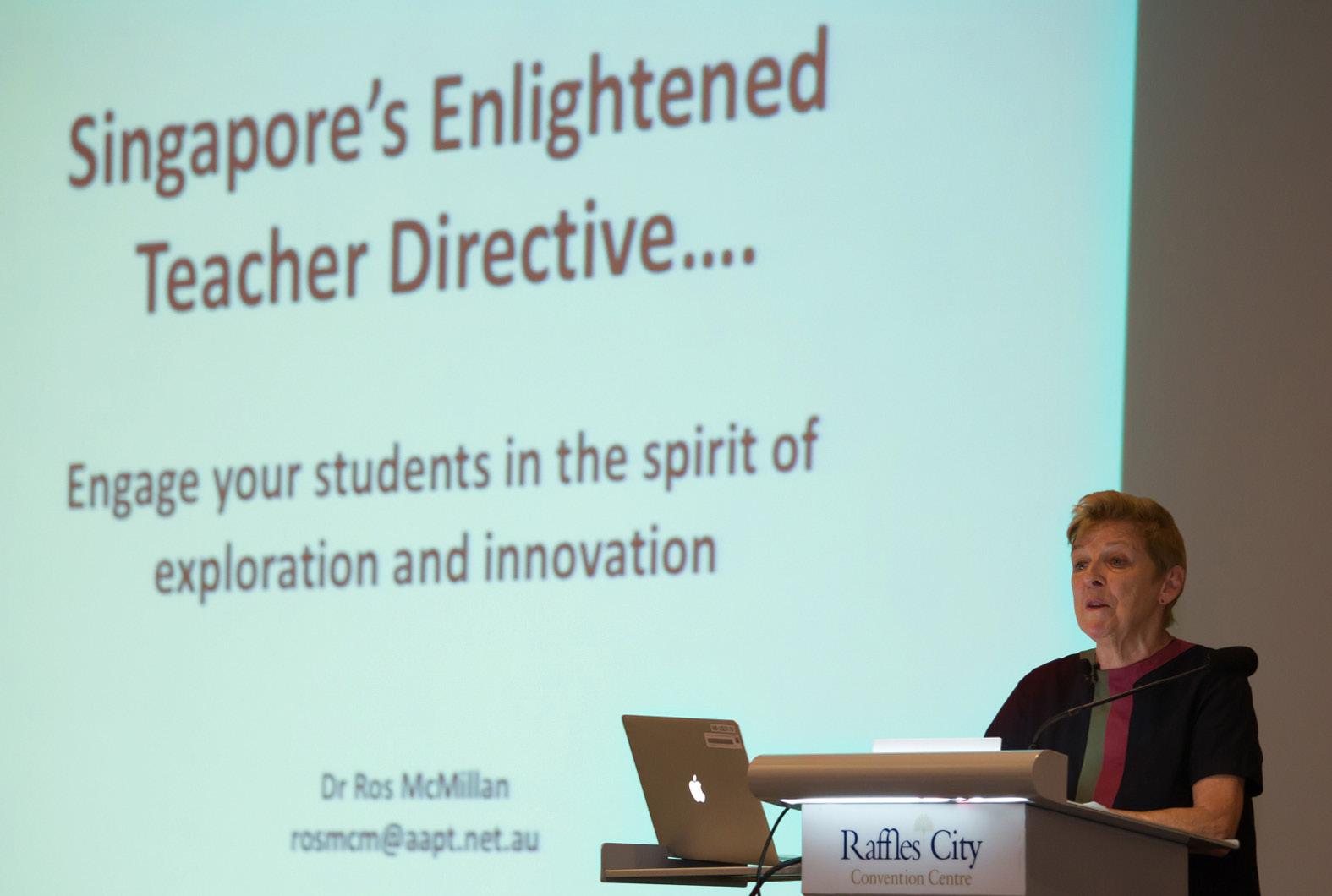
Dr Ros Mcmillan sharing the richness of musical experiences when it begins from creativity
READ
Click to view the slides on Singapore’s enlightened teacher directive: “Engage your students in the spirit of exploration and innovation” by Dr Ros McMillan
While the curriculum states that student learning consists of performing, creating and listening, for Dr Ros Mcmillan, it is first and foremost, creating.
The elements of music can be experienced in its most natural way which is through creating pieces through exploration of sound. When one plays with high and low sounds, they learn about registers; fast and slow, tempo; long and short, duration; thick and thin, texture and so on.
USING THE EARS
Imagine that there is a mass of instruments laid out in the centre of the classroom and the children are asked to pick an instrument and find three sounds that can be created with it. What sounds do you think they will find? And how do they manage to find those sounds?
They begin by exploring ways of making sounds on the instruments but throughout, they will always be listening or using their ears. This applies to even the youngest of children.
Squeaks, Squarks and Grunts
Randomly give each student in the class, a piece of paper with an animal picture on it. There are 4 animal pictures altogether, dog, cat, cow, sheep.
*You can have more animals depending on how many groups you would want the class to get into
The students would have to get themselves into their animal groups but they can only communicate by making the sound of the animal given to them.
Instead of animal sounds, you could also use common songs such as Frère Jacques, Happy Birthday, Brahms’ Lullaby etc.

Teacher volunteers using their ears to get into groups in the activity “Squeaks, Squarks and Grunts”
WATCH
ACTIVITY
Limericks
Limericks could be used to help students experience compound time. How about getting students to write their own limericks?
An example of a limerick
There was a young lady from Ryde, of eating green apples she died. Inside the lamented, the apples fermented and made cider inside her inside.
CREATING A SOUND STORY
Literacy learning could be tied in with music. A story could be expressed musically rather than just being read aloud as a storybook. Using the example of the story, “Crocodile Beat”, as the teacher flips each page, featuring an animal and the action he is doing, the students would have to discuss the characteristic of that animal and demonstrate how to use an instrument or sound to express various images.
For example, “The crocodile sleeps and awaits its prey.” Students would have to demonstrate the idea of a crocodile snoring on an instrument or voice. The teacher could assign the characters to each group and they would have to experiment with ways to portray the characters musically.
MAKING CONNECTIONS WITH OTHER SUBJECT AREAS
Besides animals, we could work based on other themes such as “flight”, “clocks and watches”, “insects”, “stars and planets” or “seasons”. And link them with a topic that the children are learning about from another subject.
If the children are learning about the different types of insects in Science lessons, we could create a story about “a swarm of insects” and compose a programmatic piece of music.
They would have to invent words to create different insect sounds, create different tones in different registers. There may be repetition involved which would delve into concepts such as ternary form. They would have to decide how to end the piece.
Click to watch Dr Ros McMillan’s Masterclass on Singapore’s enlightened teacher directive: “Engage your students in the spirit of exploration and innovation”
As the teacher opens the pages without reading anything aloud, each group must look out for their character to appear and play their motif at the appropriate time. Through this, the children are using their imagination to create sounds that match the pictures.
After the performance, the students could explain why they chose certain instruments, rhythms, dynamics etc. to portray their character. They are using their ears to make musical decisions.
It is through involving students in the musicmaking process that engages them and gives them ownership of their learning.
BUILDING THE COMMUNITY FROM THE INSIDE OUT
Community shapes our identity. It has the power to unite us in a common bond as we work together to advocate for the arts. To present the good work that our fellow arts educators have done and the impact they have made, the conference showcased a display that articulates the critical role arts educators play to shape students’ development in multiple ways and inspire other teachers.

Portraits lll: Narratives of Singapore Arts Educators
Celebrating good arts practices as a community of arts educators
Launched at AEC 2018, Portraits III is the third in a series of tributes to exemplary arts teachers. Featuring 16 arts educators sharing about their interdisciplinary work in the classroom and how they partner local and regional arts practitioners to create change in their community, their narratives were featured in a book given to all conference participants and as one of the display panels in the Canning Room. Their abiding belief in making a difference in their students guides
their practice in the classroom. Their individual journeys represent the collective identity of the arts teaching fraternity.
What are your significant stories as a teacher? Share them so that others can learn and be inspired. The transformative power of the arts moves beyond mere aesthetics to influence and impact the lives of students and to shape community.

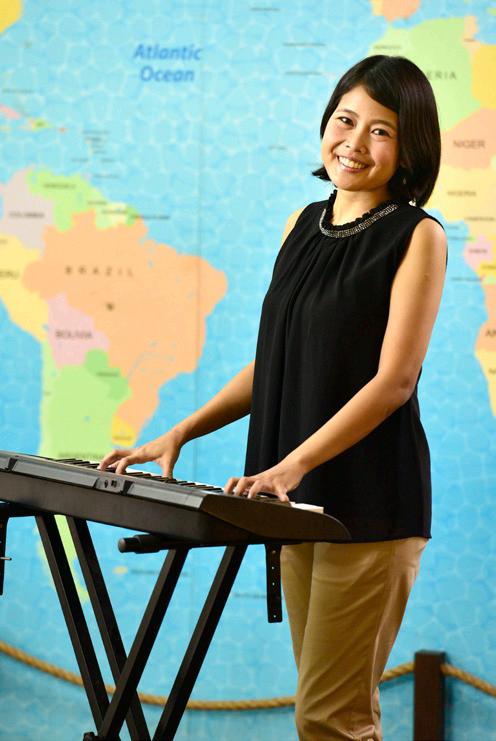

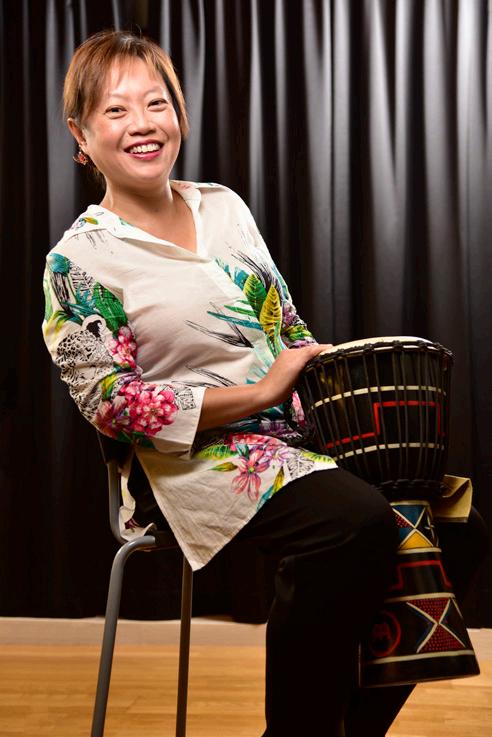





READ
Click to read the stories of our arts teacher-leaders and be inspired by their music journey and teacher identity
The 8 music educators featured in Portraits III : Narratives of Singapore Arts Educators
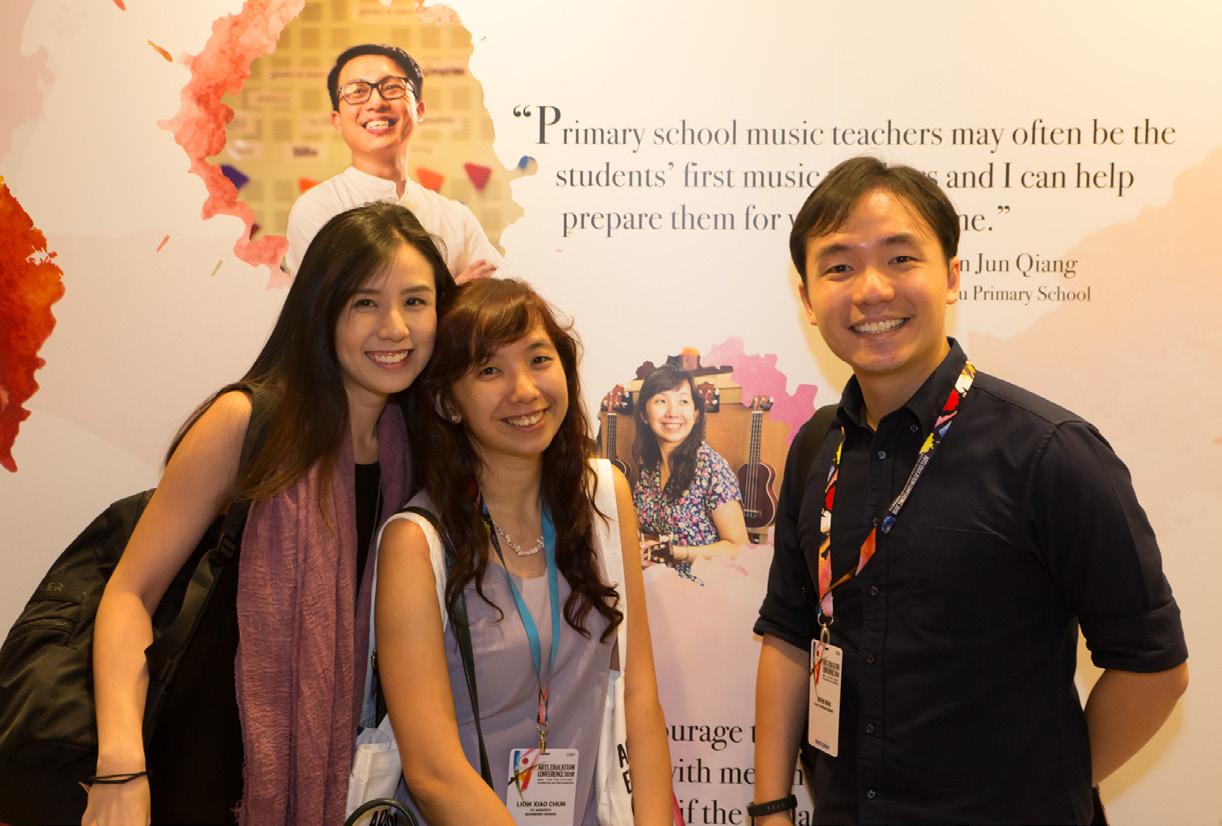
“Nowadays with technology, we can be very self-absorbed, but in music class, we learn how to sing and make music together.”
Liow Xiao Chun Music Teacher from St. Andrew’s Secondary School

“The entire process allows me to think critically about why I teach the way I do and this develops the ‘reflective practitioner’ in me.”
Ameerah Sharainee Zain Senior Teacher from Riverside Primary School
WATCH
Click to view the EWS Flashmob in action at AEC
EWS Flashmob in Action at AEC
Singing bonds students across schools

“Do Do Do Shooby Shooby Do...”, the distant voices of children could be heard approaching the Fairmont Foyer, attracting the attention of conference participants having their lunch. It was a flashmob made up of students from three primary schools, Angsana Primary School, Fuhua Primary School and Tampines Primary School, who were participants of STAR’s Engaging With Songs (EWS) programme Although these students had not rehearsed together, they were able to fill the space with a singular and unified voice. What was even more amazing was to see teacher participants of the EWS programme spontaneously join the song and dance with gusto.

Students from three primary schools singing in one voice
Such musical oneness was possible due to the common repertoire of songs and routines learnt by the various schools for the EWS programme. Whenever a teacher starts singing a line from the learnt repertoire, the children would naturally respond and join in the singing. The shared experience of singing in groups bonds and builds the community. It is this that allows singing to go beyond the classroom, beyond a specific school and forge a larger community of music making. In essence, as this flash mob amply demonstrates, singing is a great connector that brings people together within a common space.
“It was a joy to see the AEC participants smile as they watched us sing and dance. This was a meaningful flashmob that brought both students and teachers together as part of a larger singing community.”
Loh Shao Wei Music Teacher
from Yew Tee Primary School
EWS Teachers joining in the Flashmob
Teachers learning more about the Student Learning Space to enable self-directed and self-paced learning
Supporting Student Learning Beyond the Classroom
How can technology be harnessed to enable students to learn anytime, anywhere and at their own pace?


How do we prepare students to be futureready learners? One platform to empower students to drive their own learning according to their needs and interests, is through the Student Learning Space (SLS).
To give music teachers a clearer insight to what the SLS can offer, a booth was set up
to show how the SLS as a technological tool enables self-directed and self-paced learning. The booth featured the Bandlab cloud social music creation platform and showcased how students experienced music making collaboratively.
Sharing Leads to Learning
A process of continuous learning as we share and think about our own teaching approaches.
Ronald and Samuel presenting their critical inquiry project
Sharing allows us a chance to reflect on our practices. When we have an idea and we try it out in the classroom, we begin to gain new perspectives and also sharpen our pedagogical knowledge. The innovation becomes even more impactful when we share it with others. The exchange generates more ideas and sparks other possibilities that would feed back into our own practice.
The concurrent sessions and posters provided a rich platform for teachers in the fraternity to learn from one another and be inspired to explore new ideas.
CONCURRENT SESSION 1A Facilitating Theoretical Understandings of Music through Blended Learning
LIM XIAN QUAN, RONALD
Music Teacher
Pasir Ris Crest Secondary School
Can curated online platforms and plenary sessions bridge the gaps between music theory and musical experiences?
The session explored concepts of a flipped classroom and blended learning to facilitate students’ theoretical understandings of music.
Click to view the slides on Facilitating Theoretical Understandings of Music through Blended Learning
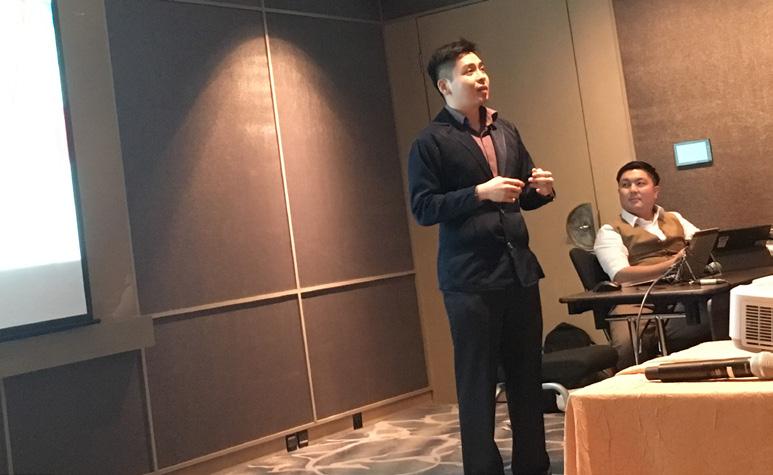
CONCURRENT SESSION 1B Critically Evaluating the Benefits of Deliberate Online Social Spaces for Students’ Learning
SAMUEL SOONG RUI
Music Teacher
Evergreen Secondary School
How can we meaningfully harness technology to facilitate students’ song-writing process? How can the use of online social learning spaces empower students and give them greater ownership in their learning?
The session discussed the benefits of deliberate online social learning spaces and showed how its use in challenging music projects such as song-writing, not only benefitted the process of song-writing but was also crucial to its outcome.
Click to view the slides on Critically Evaluating the Benefits of Deliberate Online Social Spaces for Students’ Learning
CONCURRENT
SESSION 2A Investigating Students’ Decision-Making Process in Musical Arrangements on Digital Audio
Workstations
HO TZE LIANG, SHAUN
Subject Head (Music)
Yishun Secondary School
What are some factors we need to consider when planning music lessons using Digital Audio Workstations (DAW)?
The session shared some insights on how teachers can facilitate students’ learning by giving them opportunities to make musical decisions as they arrange their music using DAW.
Click to view the slides on Investigating Students’ Decision-Making Process in Musical Arrangements on Digital Audio Workstations
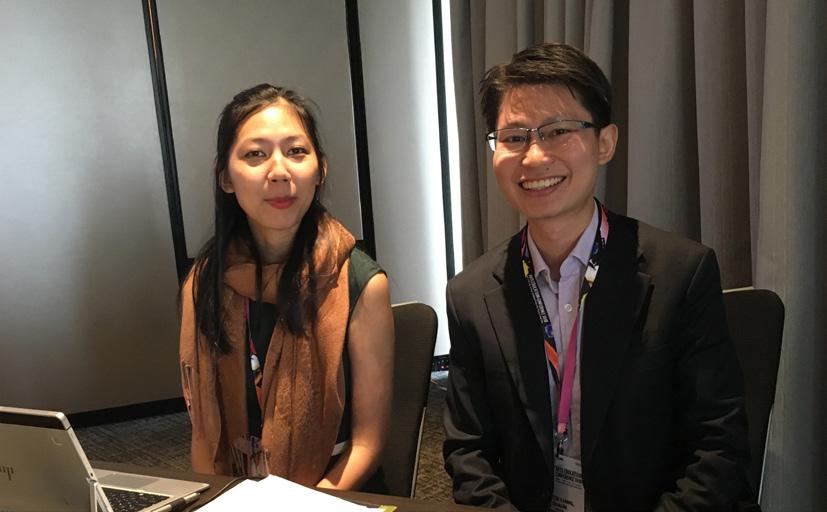
FROM THE TOP
Shaun and Si Liang inspiring others through their sharing
Agnes sharing how authentic assessment tasks can be developed
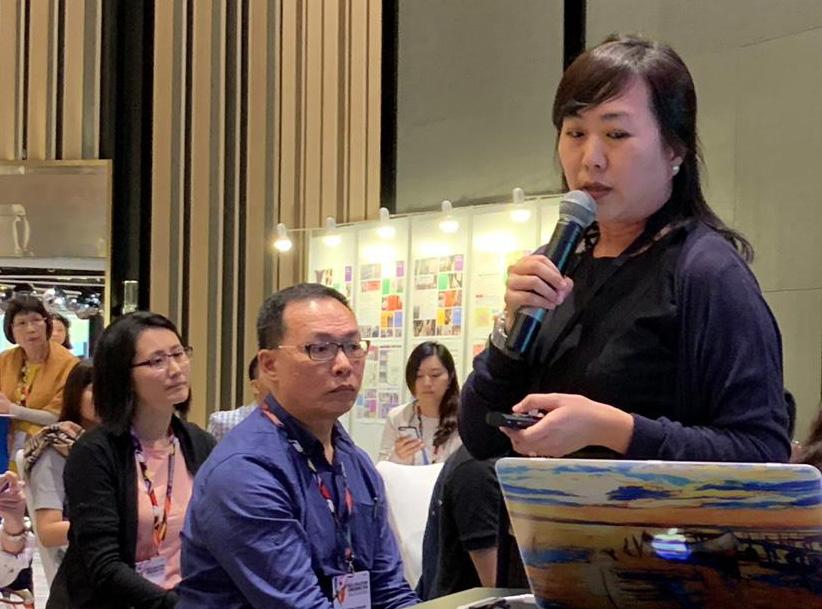
CONCURRENT SESSION 2B Taking Creative Risks: Negotiating Tensions in Teaching and Facilitating Learning in Jam Band Contexts
HO SI LIANG
Music Teacher
Deyi Secondary School
What does it mean to facilitate students’ critical thinking in a jam band Context?
The session uncovered the various tensions that a teacher might face when facilitating students’ learning as they arrange music and perform in a jam band.
Click to view the slides on Taking Creative Risks: Negotiating Tensions in Teaching and Facilitating Learning in Jam Band Contexts
CONCURRENT SESSION 3A Developing Authentic Assessment Tasks for the Music Classroom
AGNES TAN CHAI JING
Senior Specialist (Music) Arts Education Branch, SDCD
How can we design meaningful assessment tasks that are aligned to the Music Syllabus’ Learning Outcomes at the Primary and Lower Secondary levels?
The session showed some key considerations when designing assessment tasks.
Click to view the slides on Developing Authentic Assessment Tasks for the Music Classroom
Big smiles on the faces of Wee Choon, Samuel and Hwee Sian after a great sharing session with conference participants



CONCURRENT SESSION 3B Technology as Enabler to Transform the Music Teaching and Learning Practice
MARVIN LEUNG WAI CHI Senior Specialist (Music)
PAN JINGTING ALISA Arts Education Officer (Music) Arts Education Branch, SDCD
What new pedagogical approaches should we take to enable effective learning with technology?
The session illustrated how collaborative music making can take place in the Student Learning Space (SLS), an online learning platform.
Click to view the slides on Technology as Enabler to Transform the Music Teaching and Learning Practice
CONCURRENT SESSION 4A Transforming Learning Towards Students’ Ownership: Leveraging Technology and Use of Video-Focusing Techniques
LIM HWEE SIAN
Lead Teacher (Music)
Cedar Girls’ Secondary School
How can we leverage ICT to enhance students’ self-directed learning to impact their performance practice?
The session demonstrates the use of video technology to empower students to record their work in progress and to critique, evaluate and refine their performances.
Click to view the slides on Transforming Learning Towards Students’ Ownership: Leveraging Technology and Use of Video-Focusing Techniques
CONCURRENT SESSION 4B Interdisciplinary Perspectives Through the Lens of Music and Physical Education@Lianhua Primary
SIM WEE CHOON
Subject Head (Performing Arts)
WONG EE-MENG, SAMUEL
Senior Teacher (PE) Lianhua Primary School
How can the learning of music and physical education be linked meaningfully?
The session revealed the power of intersections between physical education and music as it made learning more coherent and authentic. As it promotes creative and divergent thinking, students are empowered to develop dispositions that value multiple perspectives and encourage entrepreneurial dare.
Click to view the slides on Interdisciplinary Perspectives Through the Lens of Music and Physical Education@ Lianhua Primary
FROM THE TOP
Sharing about their EWS programme:
Fiona from Clementi Primary School
Siim Wii from Xishan Primary School
April from Fuhua Primary School
Nancy from Angsana Primary School
CONCURRENT SESSION 5
Engaging with Songs Programme: From Self to School to Society
FIONA KWAN LOK MUN
Music Teacher
Clementi Primary School
LIEW SIIM WII
Subject Head (Music)
Xishan Primary School
CHUA SOO BIN APRIL
Senior Teacher (Music)
Fuhua Primary School
NG KAY GEK NANCY
Senior Teacher (Music)
Angsana Primary School
Can singing build our school culture as well as bond children across schools?
The session established how the “Engaging with Songs” programme impacted students’ character, school culture and the community.
Click to view the slides on Towards a singing culture: A school that sings by Fiona Kwan Lok Mun
Click to view the slides on Engaging with Songs Programme: From Self to School to Society by Liew Siim Wii
Click to view the slides on Engaging with Songs Programme: From Self to School to Society by Chua Soo Bin April
Click to view the slides on A Joyful Connection Singing and Learning by Ng Kay Gek Nancy
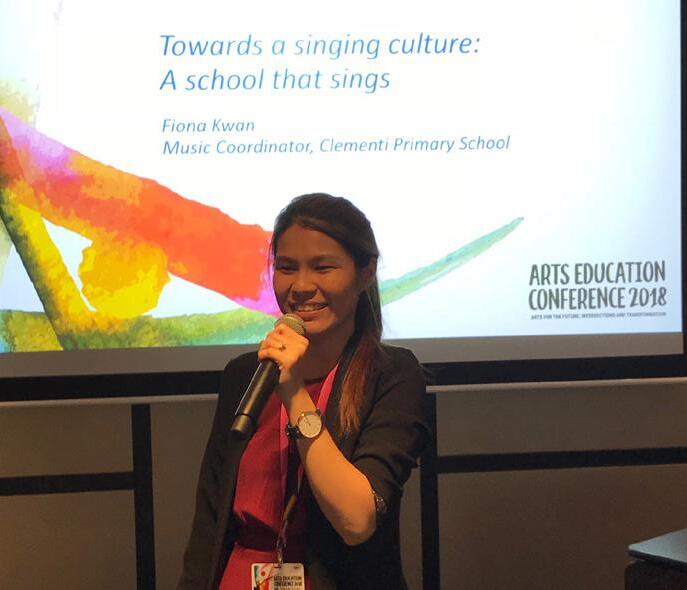
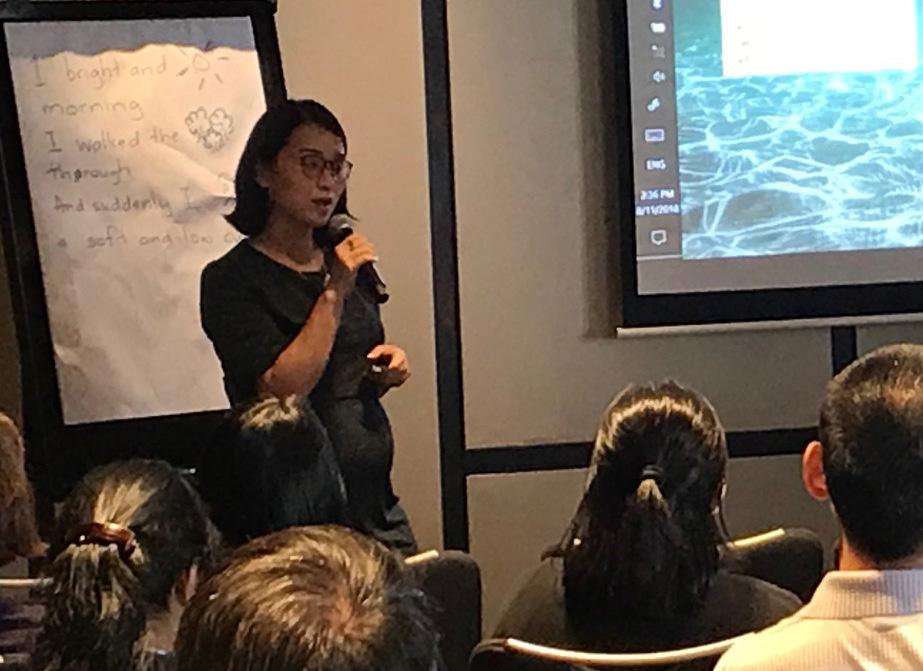
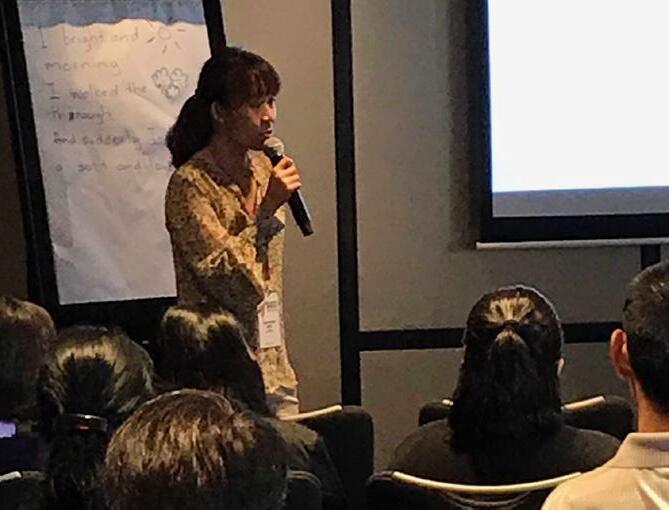


LEFT

CONCURRENT
SESSION 6A
Questioning as a Metacognitive Process to Encourage Creative Thinking in Student Composers
LAU HOUW PING
Senior Arts Education Officer (Music)
Arts Education Branch, SDCD
What kinds of questions should students ask themselves so that they can be more creative in their music compositional writing?
The session discussed different metacognitive strategies to encourage self-regulated creative thought in student composers through a routine of selfquestioning which enable students to venture beyond traditional conventions and selfevaluate their works.
Click to view the slides on Questioning as a Metacognitive Process to Encourage Creative Thinking in Student Composers
Houw Ping discussing different metacognitive strategies with conference participants RIGHT
Tah Choe, Theodora, Xiu Min and Deborah inspiring conference participants with their ideas on collaborative creative music-making
CONCURRENT SESSION 6B Collaborative Musicmaking in Choirs: Implications for Music Education
THEODORA HUANG
Arts Education Officer (Music)
CHONG XIU MIN
Arts Education Officer (Music)
DEBORAH GAN
Senior Arts Education Officer (Music)
DR. GOOI TAH CHOE
Senior Arts Education Officer (Music)
Arts Education Branch, SDCD
How does collaborative creative musicmaking impact students’ musical learning and development of personal dispositions?
The session described the possible approaches and roles of students and facilitators in the creative music-making process.
Click to view the slides on Collaborative Music-making in Choirs: Implications for Music Education
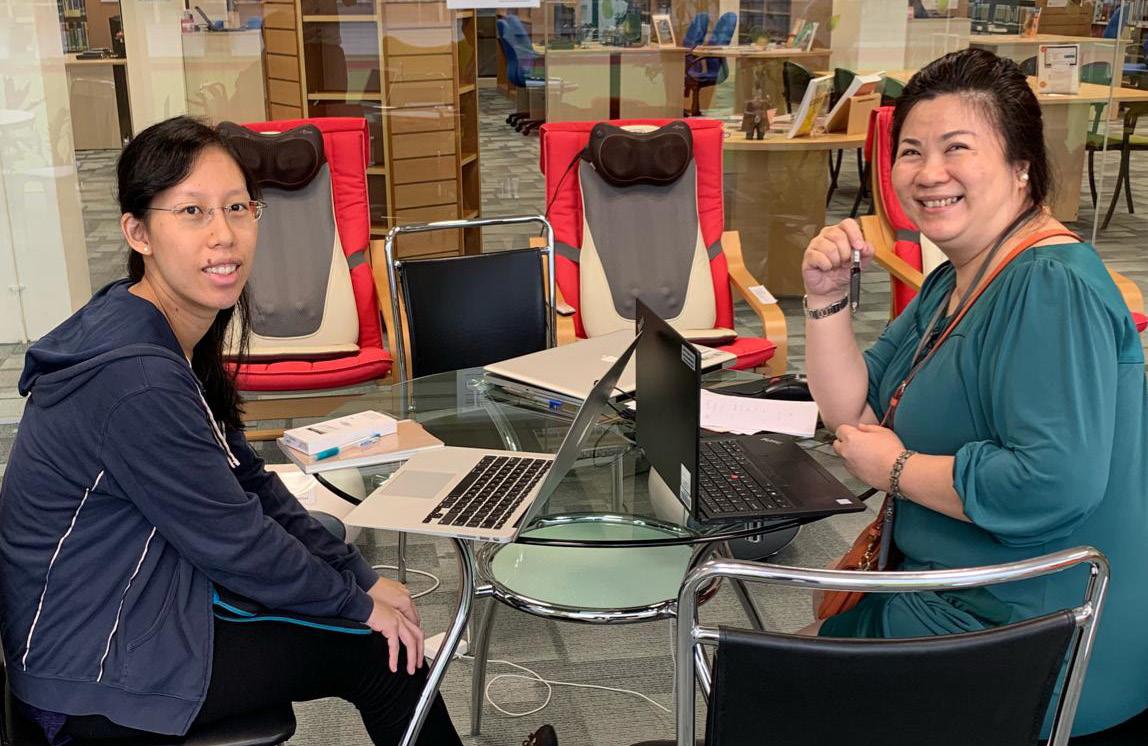
In preparation of their presentation, Denise and Irene met up to discuss how teaching and learning can be enhanced through meaningful partnerships
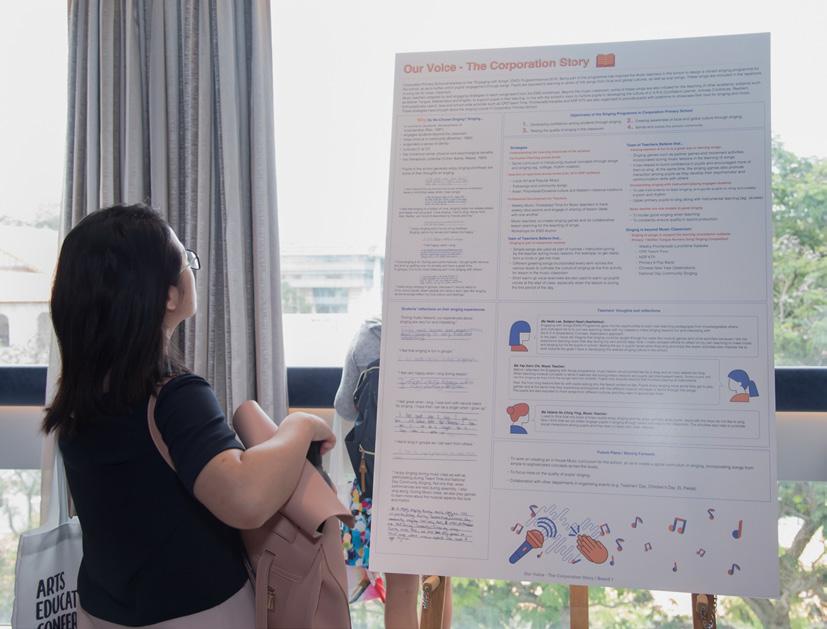
CONCURRENT
SESSION 7 Intersections Through Partnerships
CHAN MEI YIN IRENE
Lead Teacher (Music)
West Grove Primary School
LEE SHU HUI DENISE
Music Teacher
National Junior College
How can partnerships enhance music pedagogical practice as well as present possibilities for interdisciplinary and studentcentric learning?
The session examined different models of partnerships to foster intersections in knowledge that contribute to enriching music learning for students and the teachers’ own pedagogical practices.
Click to view the slides on Intersections Through Partnerships
A section of the displays was dedicated to posters that illustrate how music making can be facilitated in ways that stimulate students’ musical learning.
CREATIVE MUSIC-MAKING: A SHOWCASE OF 10 MUSIC TEACHING APPROACHES
Nurturing students’ musical identities, requires the teacher to consider the processes in facilitating music-making, the resources available and the students’ profile while giving voice to the students to express themselves. 10 teacher-leaders showcased their approaches and lesson ideas to engage students in creative music-making that involves active listening, creating, performing, improvising, exploring, and collaborating. Their posters shared how the music classroom could be made into a fun and dynamic learning space.
NURTURING A SINGING CULTURE AND DEVELOPING CHARACTER THROUGH SONG
The voice is the first instrument that the students have which can be harnessed to extend the love for singing and learning music beyond the classroom. When local and community songs are incorporated in music lessons, it can help engender a singing culture in the school community and instill values to prepare students as future learners.
Lesson ideas and teaching approaches are shared through pedagogical boards
READ
Click to view the posters on Creative Music Making: A Showcase of 10 Music Teaching Approaches
Click to view the posters on Nurturing a singing culture and developing character through song
Readying Ourselves for an Unpredictable Future
Deputy Director-General of Education (Professional Development) and Executive Director, Academy of Singapore Teachers, Mrs Chua Yen Ching encapsulated the learnings of the day in her closing address.







DyDGE (PD) Mrs
a ruler to
demonstrate
how different mental models can be adopted
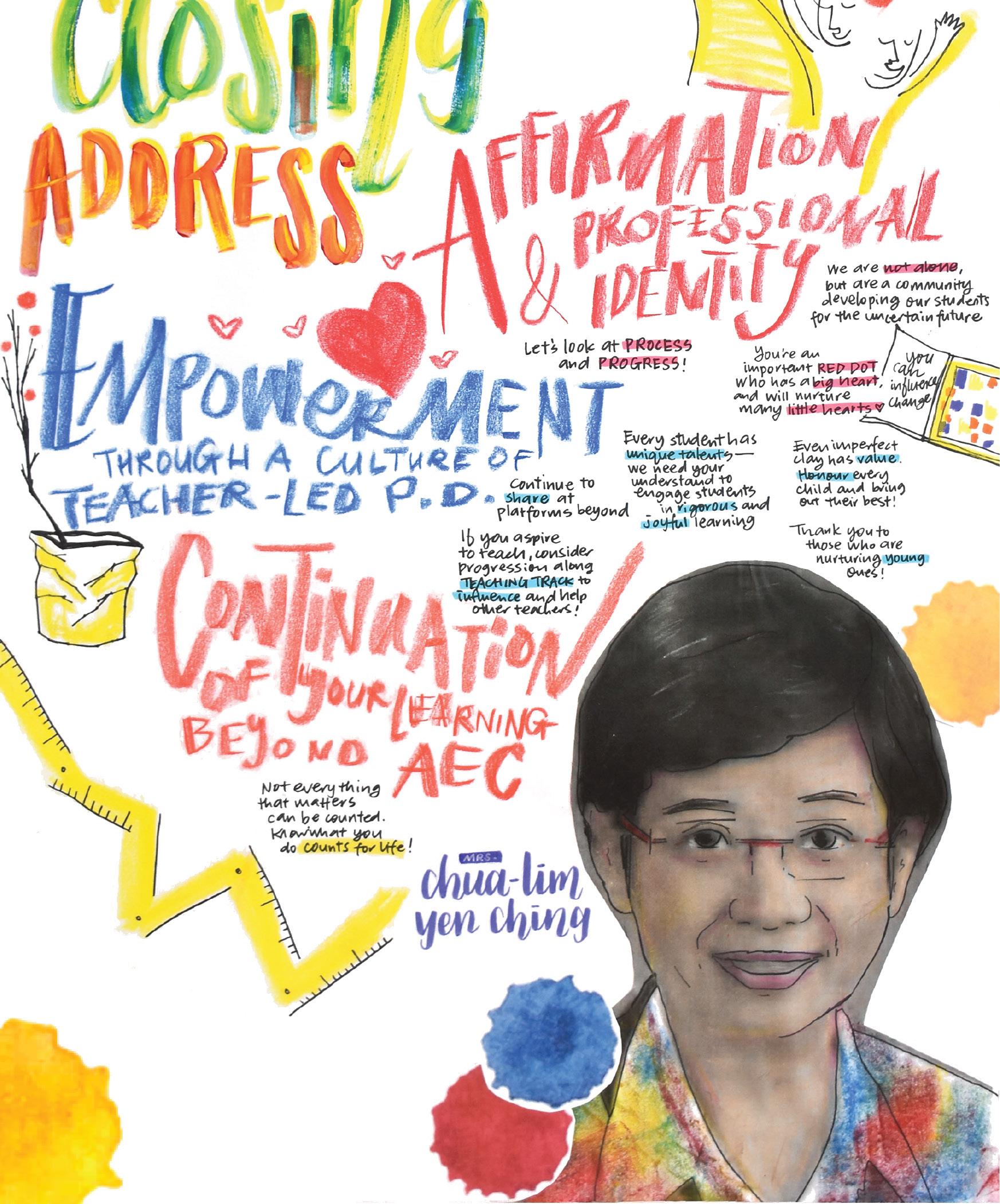


“Put your heart in the mission and the mission will always be in your heart.”
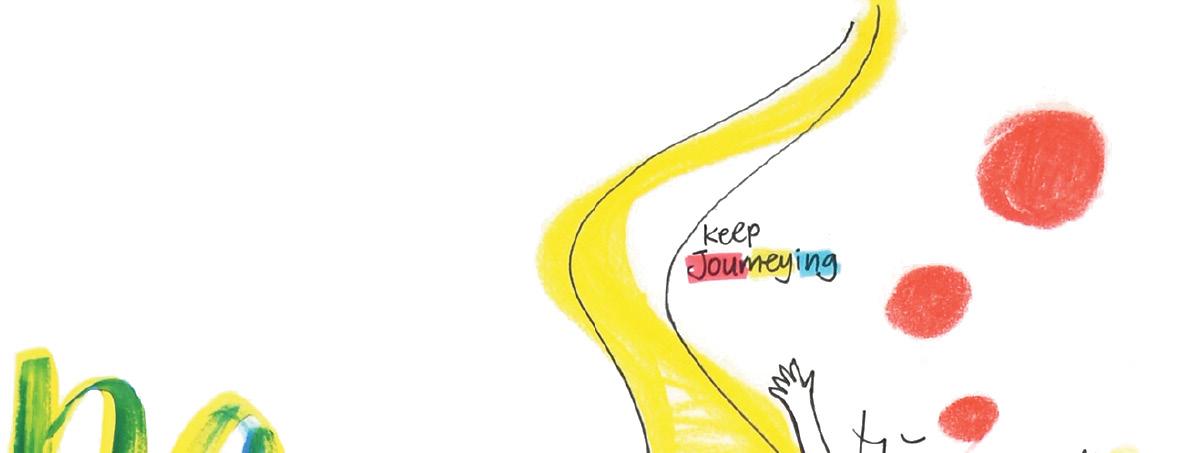


Chua Yen Ching using
We’d Love to Hear from You…

LEE HUAN SIAK JAMES
Deputy Director (Music)
Lee_Huan_Siak@moe.gov.sg
+65 6664 1493
CHAN YEN SEE
Master Teacher (Music)
Chan_Yen_See@moe.gov.sg
+65 6664 1499
SURIATI BTE SURADI
Master Teacher (Music)
Suriati_Suradi@moe.gov.sg
+65 6664 1498
CHUA SIEW LING
Master Teacher (Music)
Chua_Siew_Ling@moe.gov.sg
+65 6664 1554
KELLY TANG
Master Teacher (Music) Kelly_Tang@moe.gov.sg
+65 6664 1561
TAN LI JEN ADELINE
Senior Academy Officer (Music)
Adeline_Tan@moe.gov.sg
+65 6664 1494
CHAN YU LING JOSEPHINE
Senior Academy Officer (Music)
Josephine_Chan@moe.gov.sg
+65 6664 1555
ENG YAN CHEN ALVYN
Academy Officer (Music) Alvyn_Eng@moe.gov.sg
+65 6664 1497
